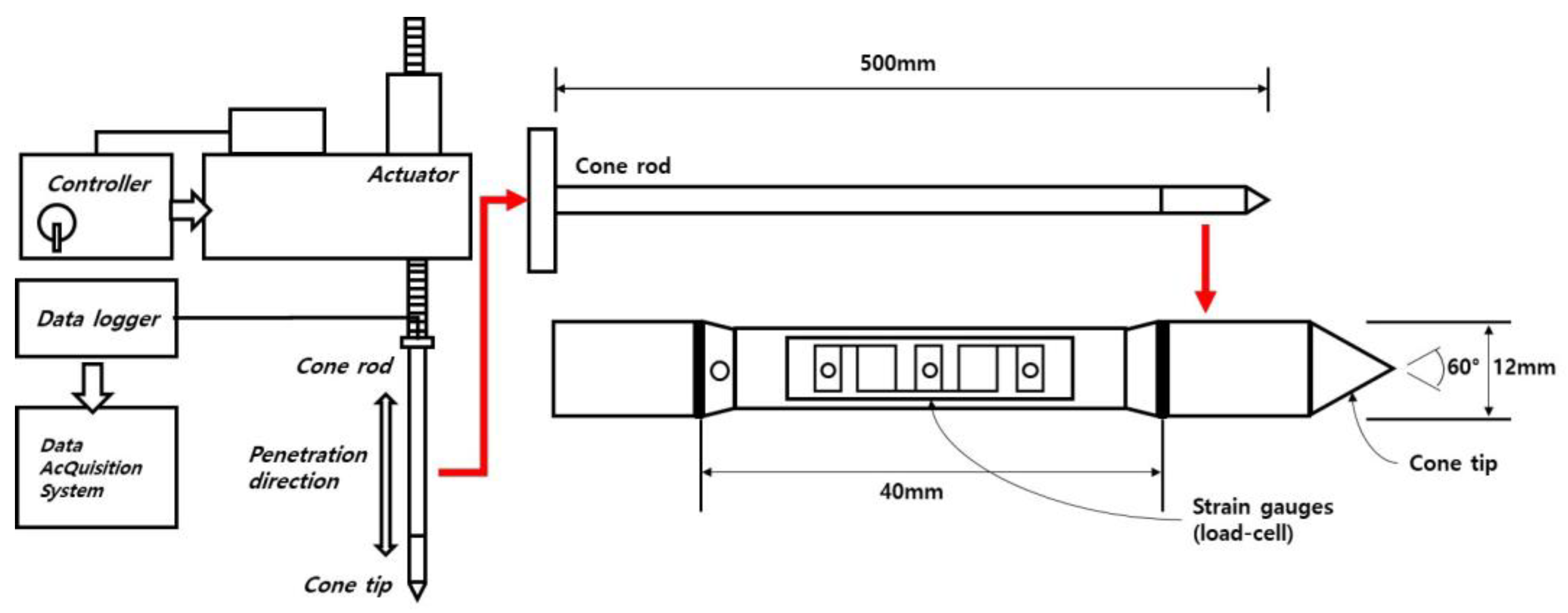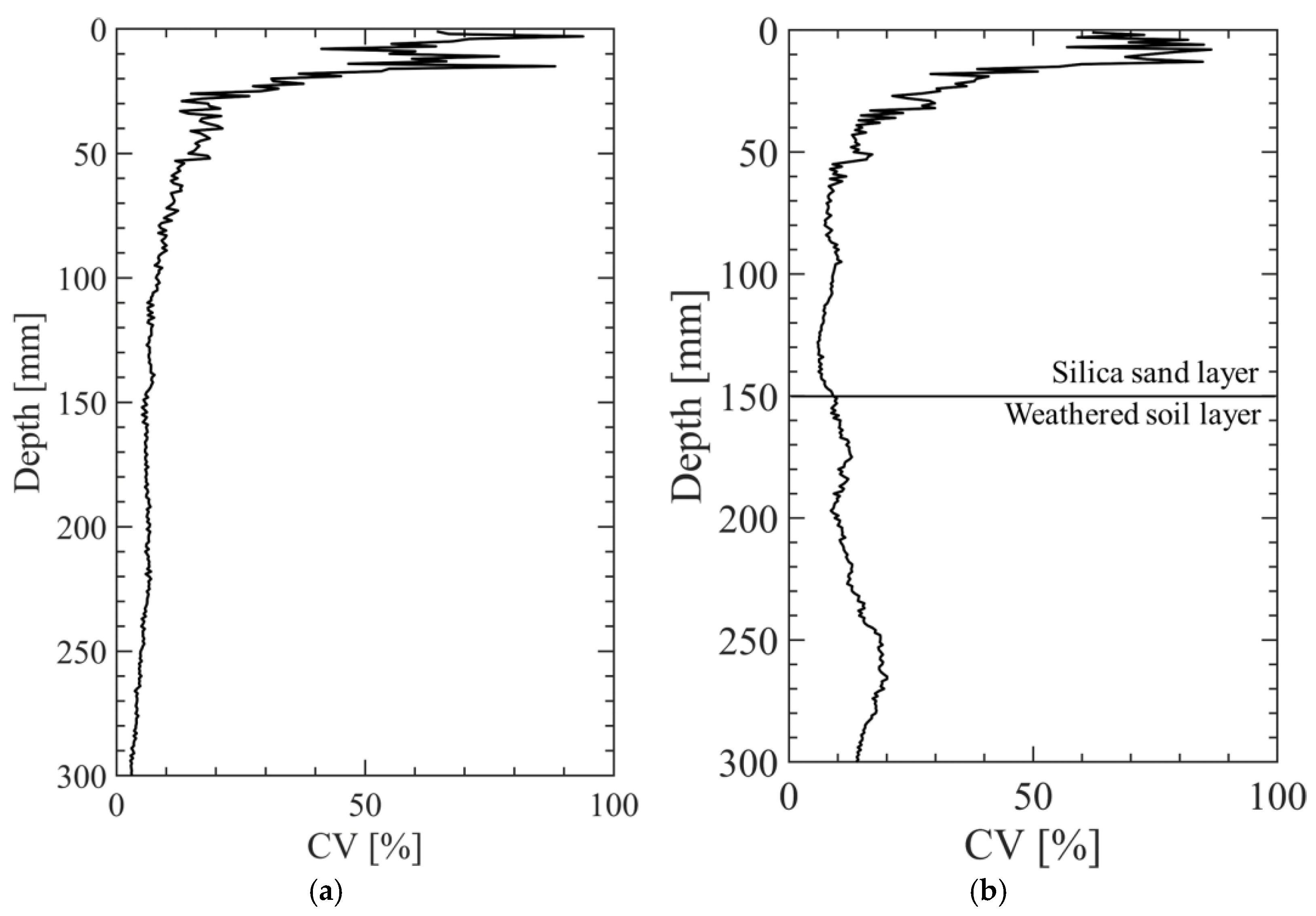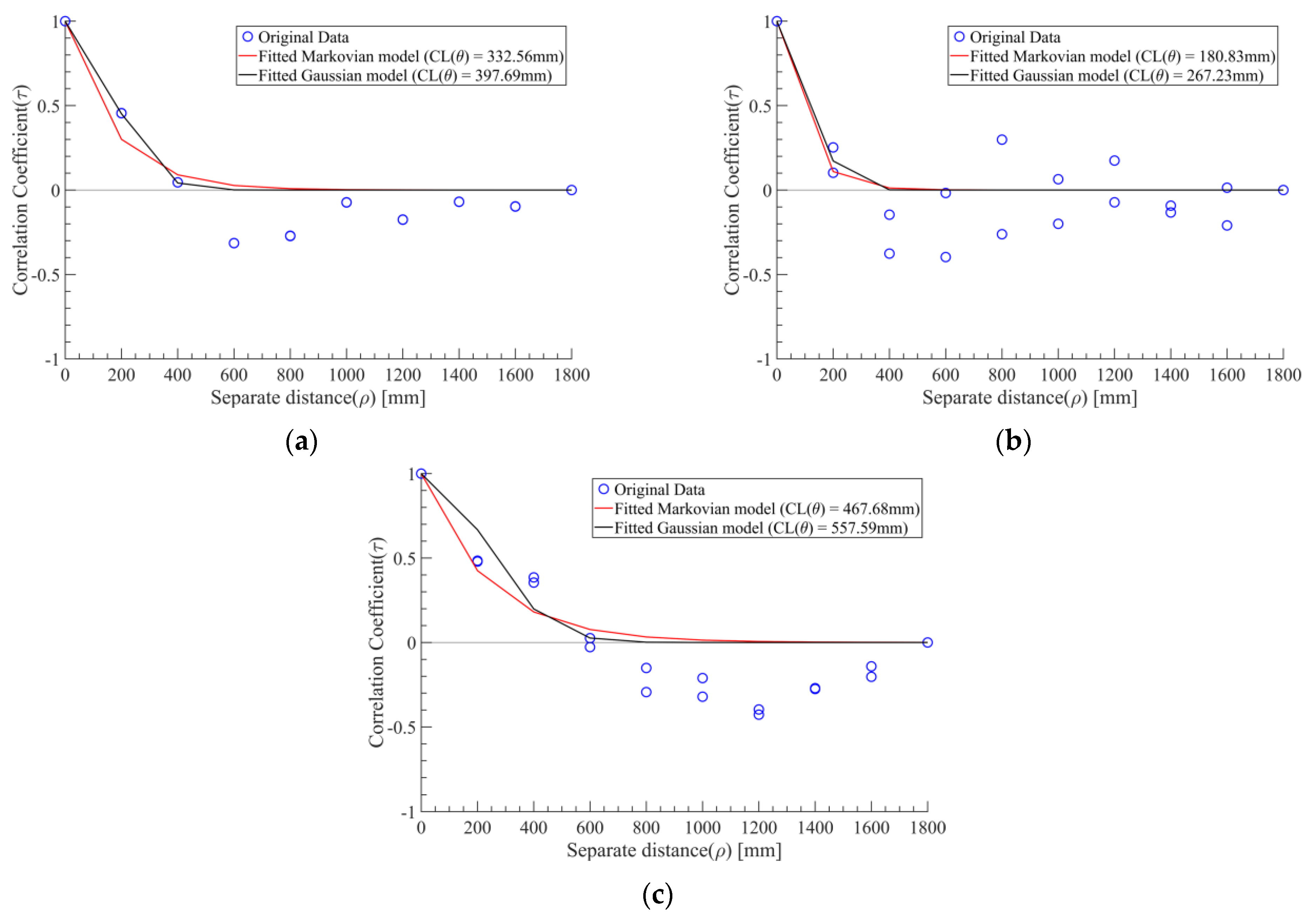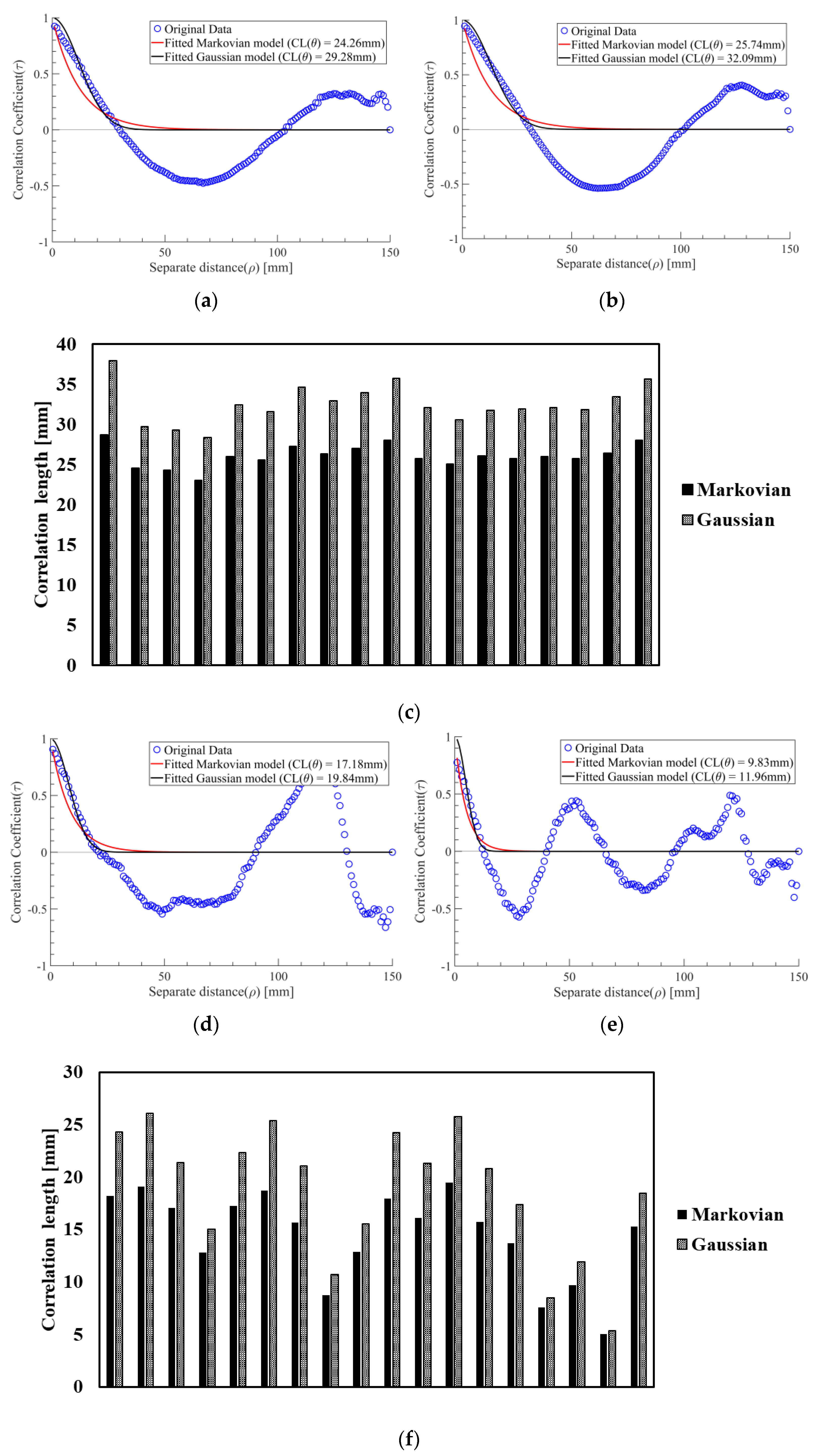Assessment of Spatial Variability in Ground Models Using Mini-Cone Penetration Testing
Abstract
:1. Introduction
2. Theoretical Background
2.1. Spatial Variability in the Ground
2.2. Coefficient of Variation (CV)
- = standard deviation of cone penetration resistance.
- = mean of cone penetration resistance.
2.3. Correlation Length (CL)
- = a pair of values at two points with a separation distance τ.
2.4. Mini-Cone Penetration Test (Mini-CPT)
- Cone penetration speed;
- Distance from the bottom surface of the ground model;
- Distance from the soil tank walls;
- Particle size effect ();
3. Experimental Program
3.1. Soil Index Properties
3.2. Technical Specifications
3.3. Ground Models
4. Discussion of the Results
4.1. CPT Test Results
4.2. CV Analysis
4.3. CL Analysis
4.3.1. Horizontal CL
4.3.2. Vertical CL
5. Conclusions
- Below the 50 mm threshold, the coefficient of variation (CV) was found to be relatively stable. Especially, in the silica sand ground model, the average CV was measured at 6.76%, indicating minimal variability and suggesting a well-composed homogeneous ground model. In contrast, the weathered soil ground model exhibited a CV of 13.70%, showing a comparatively higher level of variability than that of the silica sand ground model.
- The horizontal CL was calculated using the average cone penetration resistance measured at each point. The CL for the silica sand ground in the two-soil layer was calculated to be smaller than that for the silica sand ground in the single soil layer and the weathered soil ground in the two-soil layer. This is believed to be due to the lower penetration depth in the silica sand ground of the two-soil layer, and the impact of having fewer data points (smaller separation distances). This suggests that further research may be needed, such as conducting experiments with more data points or deeper penetration.
- In the calculation of vertical CLs, the CV for the silica sand layer was observed to be very low, confirming the validity of the CL calculations. In contrast, the CV for the weathered soil layer was relatively high. This is believed to be a result of the homogeneous particles of the silica sand layer and the various particles of the weathered soil layer, which are considered to be the primary influencing factors on vertical CLs.
- The results of this experiment, conducted under the assumption of a homogeneously built ground model, revealed that the ground model exhibits less variability compared to the average variability observed in the field. The observed variability suggests that evaluating spatial variability through field and laboratory tests requires careful consideration of the non-homogeneity present in field conditions.
Author Contributions
Funding
Institutional Review Board Statement
Informed Consent Statement
Data Availability Statement
Conflicts of Interest
References
- Lacasse, S.; Nadim, F. Uncertainties in Characterizing Soil Properties. In Uncertainty in the Geologic Environment: From Theory to Practice; Shackleford, C.D., Nelson, P.P., Roth, M.J.S., Eds.; ASCE Geotechnical Special Publication: Reston, VA, USA, 1996; pp. 49–75. [Google Scholar]
- Elkateb, T.; Chalaturnyk, R.; Robertson, P.K. An Overview of Soil Heterogeneity: Quantification and Implications on Geotechnical Field Problems. Can. Geotech. J. 2002, 40, 1–15. [Google Scholar] [CrossRef]
- Griffiths, D.V.; Fenton, G.A. Bearing Capacity of Spatially Random Soil: The undrained Clay Prandtl Problem Revisited. Geotechnique 2001, 51, 351–359. [Google Scholar] [CrossRef]
- Koutsourelakis, S.; Prevost, J.H.; Deodatis, G. Risk Assessment of an Interacting Structure-soil System due to Liquefaction. Earthq. Eng. Struct. Dyn. 2002, 31, 851–877. [Google Scholar] [CrossRef]
- Haldar, S.; Babu, G.L.S. Effect of Soil Variability on the Response of Laterally Loaded Pile in Undrained Clay. Comput. Geotech. 2007, 35, 537–547. [Google Scholar] [CrossRef]
- Lenz, J.A.; Baise, L.G. Spatial variability of liquefaction potential in regional mapping using CPT and SPT data. Soil Dyn. Earthq. Eng. 2007, 27, 690–702. [Google Scholar] [CrossRef]
- Vivek, B.; Raychowdhury, P. Probabilistic Approach for Evaluation of Soil Liquefaction Considering Spatial Variability of Soil. In Proceedings of the Indian Geotechnical Conference, Kochi, India, 15–17 December 2011. [Google Scholar]
- Cho, S.E. Probabilistic analysis of seepage that considers the spatial variability of permeability for an embankment on soil foundation. Eng. Geol. 2012, 133–134, 30–39. [Google Scholar] [CrossRef]
- Saygili, G. Probabilistic Assessment of Soil Liquefaction Considering Spatial Variability of CPT Measurements. Georisk 2016, 11, 197–207. [Google Scholar] [CrossRef]
- Cho, S.E.; Park, H.C. Probabilistic Stability Analysis of Slopes by the Limit Equilibrium Method Considering Spatial Variability of Soil Property. J. Korean Soc. Geotech. Eng. 2009, 25, 13–25. [Google Scholar]
- Jaksa, M.B.; Goldsworthy, J.S.; Fenton, G.A.; Kaggwa, W.S.; Griffiths, D.V.; Kuo, Y.L.; Poulos, H.G. Towards reliable and effective site investigations. Géotechnique 2005, 55, 109–121. [Google Scholar] [CrossRef]
- Suchomel, R.; Masín, D. Comparison of different probabilistic methods for predicting stability of a slope in spatially variable c–φ soil. Comput. Geotech. 2015, 37, 132–140. [Google Scholar] [CrossRef]
- Naghibi, F.; Fenton, G.A.; Griffiths, D.V. Probabilistic considerations for the design of deep foundations against excessive differential settlement. Can. Geotech. J. 2016, 53, 1167–1175. [Google Scholar] [CrossRef]
- Griffiths, D.V.; Fenton, G.A. Three-dimensional seepage through spatially random soil. J. Geotech. Geoenviron. Eng. 1997, 123, 153–160. [Google Scholar] [CrossRef]
- Hicks, M.A.; Spencer, W.A. Influence of heterogeneity on the reliability and failure of a long 3D slope. Comput. Geotech. 2016, 37, 948–955. [Google Scholar] [CrossRef]
- Li, Y.J.; Hicks, M.A.; Vardon, P.J. Uncertainty reduction and sampling efficiency in slope designs using 3D conditional random fields. Comput. Geotech. 2016, 79, 159–172. [Google Scholar] [CrossRef]
- Tom, D.G.; Philip, J.V.; Michael, A.H. Assessment of soil spatial variability for linear infrastructure using cone penetration test. Géotechnique 2021, 71, 999–1013. [Google Scholar]
- Sert, S.; Luo, Z.; Xiao, J.H.; Gong, W.P.; Juang, C.H. Probabilistic analysis of responses of cantilever wall-supported excavations in sands considering vertical spatial variability. Comput. Geotech. 2016, 75, 182–191. [Google Scholar] [CrossRef]
- Zhao, T.; Wang, Y.; Xu, L. Efficient CPT locations for characterizing spatial variability of soil properties within a multilayer vertical cross-section using information entropy and Bayesian compressive sensing. Comput. Geotech. 2021, 137, 104260. [Google Scholar] [CrossRef]
- Hu, Y.; Wang, Y. Evaluating statistical homogeneity of cone penetration test (CPT) data profile using auto-correlation function. Comput. Geotech. 2024, 165, 105852. [Google Scholar] [CrossRef]
- Vanmarcke, E.H. Random Fields: Analysis and Synthesis; The MIT Press: Cambridge, MA, USA, 1983. [Google Scholar]
- DeGroot, D.J.; Baecher, G.B. Estimating Autocovariance of In-situ Soil Properties. J. Geotech. Eng. 1993, 119, 147–166. [Google Scholar] [CrossRef]
- Jones, A.L.; Steven, L.K.; Perdo, A. Estimation of Uncertainty in Geotechnical Properties for Performance-Based Earthquake Engineering; Pacific Earthquake Engineering Reserch Center, College of Engineering, University of California: Los Angeles, CA, USA, 2002. [Google Scholar]
- Padilla, J.D.; Vanmarcke, E.H. Settlement of Structures on Shallow Foundations; Research Report R74-9; Department of Civil Engineering, MIT: Cambridge, UK, 1974. [Google Scholar]
- Onyejekwe, S.; Kang, X.; Ge, L. Evaluation of the scale of fluctuation of geotechnical parameters by autocorrelation function and semivariogram function. Eng. Geol. 2016, 214, 43–49. [Google Scholar] [CrossRef]
- Robertson, P.K.; Campanella, R.G. Guidelines for Geotechnical Design Using CPT and CPTU; University of British Columbia, Vancouver, Department of Civil Engineering, Soil Mechanics Series: Vancouver, BC, Canada, 1988. [Google Scholar]
- Lunne, T.; Robertson, P.K.; Powell, J.J.M. Cone Penetration Testing in Geotechnical Practice; Chapman & Hall: London, UK, 1997. [Google Scholar]
- Kim, H.J.; Kim, D.J.; Kim, D.S.; Choo, Y.W. Development of Miniature Cone and Characteristics of Cone Tip Resistance in Centrifuge Model Tests. J. Korean Soc. Civ. Eng. 2013, 33, 631–642. [Google Scholar]
- Kim, J.H.; Choo, Y.W.; Kim, D.J.; Kim, D.S. Miniature Cone Tip Resistance on Sand in a Centrifuge. J. Geotech. Geoenvironmental. Eng. 2016, 142, 04015090. [Google Scholar] [CrossRef]
- Jeong, S.G.; Moon, M.S.; Kim, D.H. Applicability of Mini-Cone Penetration Test Used in a Soil Box. J. Korean Geosynth. Soc. 2023, 22, 83–92. [Google Scholar]
- Bolton, M.D.; Gui, M.W.; Garnier, J.; Corte, J.F.; Bagge, G.; Laue, J.; Renzi, R. Centrifuge cone penetration tests in sand. Géotechnique 1999, 49, 543–552. [Google Scholar] [CrossRef]
- Been, K.; Crooks, J.H.A.; Becker, D.E.; Jefferies, M.G. The cone penetration test in sands: Part I, state parameter interpretation. Geotechnique 1986, 36, 239–249. [Google Scholar] [CrossRef]
- Gui, M.W.; Bolton, M.D.; Garnier, J.; Corte, J.F.; Bagge, G.; Laue, J.; Renzi, R. Guidelines for cone penetration tests in sand. Centrifuge 1998, 98, 1998. [Google Scholar]







| Sand | Silica Sand | Weathered Soil |
|---|---|---|
| 2.65 | 2.69 | |
| 1.06 | 1.12 | |
| 0.64 | 0.44 | |
| 1.03 | 3.57 | |
| 1.76 | 9.28 | |
| SP | SM |
Disclaimer/Publisher’s Note: The statements, opinions and data contained in all publications are solely those of the individual author(s) and contributor(s) and not of MDPI and/or the editor(s). MDPI and/or the editor(s) disclaim responsibility for any injury to people or property resulting from any ideas, methods, instructions or products referred to in the content. |
© 2024 by the authors. Licensee MDPI, Basel, Switzerland. This article is an open access article distributed under the terms and conditions of the Creative Commons Attribution (CC BY) license (https://creativecommons.org/licenses/by/4.0/).
Share and Cite
Jeong, S.; Lee, Y.; Kim, H.; Park, J.; Kim, D. Assessment of Spatial Variability in Ground Models Using Mini-Cone Penetration Testing. Appl. Sci. 2024, 14, 5670. https://doi.org/10.3390/app14135670
Jeong S, Lee Y, Kim H, Park J, Kim D. Assessment of Spatial Variability in Ground Models Using Mini-Cone Penetration Testing. Applied Sciences. 2024; 14(13):5670. https://doi.org/10.3390/app14135670
Chicago/Turabian StyleJeong, Sugeun, Yonghee Lee, Haksung Kim, Jeongseon Park, and Daehyeon Kim. 2024. "Assessment of Spatial Variability in Ground Models Using Mini-Cone Penetration Testing" Applied Sciences 14, no. 13: 5670. https://doi.org/10.3390/app14135670
APA StyleJeong, S., Lee, Y., Kim, H., Park, J., & Kim, D. (2024). Assessment of Spatial Variability in Ground Models Using Mini-Cone Penetration Testing. Applied Sciences, 14(13), 5670. https://doi.org/10.3390/app14135670






